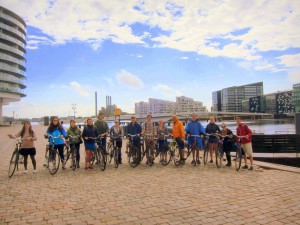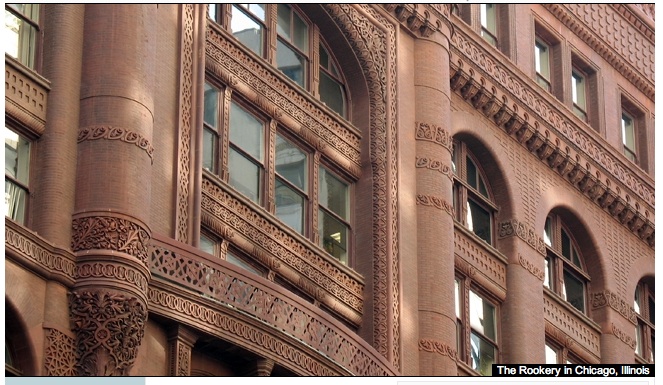I believe in science the same way most Christians believe in God: with faith, rather than understanding. I trust logic and order that science offers as explanation for my reality without real comprehension. Humanity inherently sees scientific and technological innovation as both threatening and liberating. Will it turn on us one day? Will it eventually offer us paradise?
— Olivia Storm, BFA 2012, member of the Rude Brood, Portland, Oregon
In their inaugural video to announce the opening of their June 2012 White Box exhibit, The Rude Brood showed us an anonymous hand crudely slapping coffee grounds into an auto-coffee maker: “Thwap!” Steam wafts off the appliance, the mystery hand pushes the start button, and black fluid flows into the carafe. We see a counter top littered with java grounds, and a lone coffee mug. The hand reappears to pour hot coffee into the white mug. The mug is turned to reveal a horned skull. As if this image is not quizical enough, the skull seems to be frozen, mouth open in jest or gesture. This is the Rude Brood’s coat-of-arms: the skull human remains are decoratively surrounded by acanthus, a crown tops the shield-like image, and a fist holds tightly to two decidely non-digital tools, paintbrush and x-acto knife. The words “Rare Breed” grace the emblem in a ribbon-swirl. Undoubtedly, the students of the Rude Brood knew their audience would be captivated by this crest, and, indeed as you stare, the skull sticks out its tongue and blows. The caption bluntly reads, “Brewed Rude.”
And, so is your first experience with the Rude Brood, the 12 digital arts students who completed their Bachelor of Fine Arts in the Portland Digital Arts Program at the White Stag, spring 2012. For spring term 2012, the Rude Brood percolated under the guidance of Colin Ives, UO Professor of Digital Art. Previously, the group had been instructed by Craig Hickman (fall term, 2011) and John Park (winter 2012). Coming together in Portland for the final three terms that would culminate in receiving their Bachelor of Fine Arts degrees, the Rude Brood’s ideas bubbled and brewed finding increased expression and clarity with each review and project. You may preview images of the final review on the University of Oregon: School of Architecture and Allied Arts Facebook page.
In her artist statement (reproduced in part in the quote above), Olivia Storm offers a glimpse into the curious, skeptical, and questioning nature of the Brood. Proudly owning up to their penchant to be disruptive, the Rude Brood was particularly bent on exposing and investigating the world they were about to wholeheartedly, and post-graduation, venture into. The Rude Brood designated the maxim of Choose Your Weapon to represent their oeurve. Their “weapons” perhaps sybolically represented in their Rude Brood crest (a paint brush and an x-acto knife)—came across as the weapons of their process: not necessarily violent but containing the potential to be disturbing; not specifically aggressive but capable of creating works ranging from frightening to uncomfortable. The Brood shows a vulnerability, an aggression and a demand to be heard, here and now, balanced with the pride and confidence of well-educated youth. Their work brazenly explores themes of suffering, nostalgia, commitment, and the human capability for communication. With that intention, the students presented a wide range of work varing from explorations of the horror film genre to a complete on-film exploration of self-help advice and “how to be successful.” And that’s just the beginning.
Just look at Michael Cooper’s contraption. Almost hinting at an “Eckardesque” appreciation and fabricated out of black leather, reflecting mirrors, and cold welded metal, a cell phone sits in the middle filming what is going on in front while the mirrors depict what transpires behind. One reviewer during the final review session, was overheard commenting that this object suggests an interesting “fetish-like” quality. The harness of this piece fits onto one’s shoulders and subjects the wearer to confront all angles of visual sensory perception. Cooper projects an experimental aesthetic with a nod to Da Vinci-like body accoutrements and an embrace of modern technology. Is this to evoke an idea of suffocating cerebral overload or a comment on our brave new world of constant smartphoning, where being “out of touch” simply has ceased to exist?
Rude Brooder, Grahame Bywater audiciously proposes an almost mocking sneer at expected social etiquette, privacy and confidentially. He audio broadcasts his personal secrets from inside the cavern of a whiskey barrel for all to hear (if you are so inclined to want to lean in and publicly show your interest). Should we be embarrassed to be curious? Why do we want to hear his intimate musings? Or is this one more step in the curating of our selves to others? Bywater doesn’t seem to care—he puts it out there, but sinks his secrets well within the barrel. His audience has to show their interest thus exhibiting care, empathy, compassion, and, for a few moments, granting him our full attention.
So eager and experimental was another, Tyler Centanni migrated off to uncover a “real world ” experience devoting himself to three months of door-to-door sales in a corner of suburbia. He opted for a shirt and tie, hair slicked back, attempted a “dressed-up” assemblage. His experiment culminated in marriage to his girlfriend during the final review officiated by another Rude Brood student. Reviewers and bystanders were left to question the seriousness of this ultimate evocative gesture and wonder if he thumbed his nose at button-downed tradition or truly was about to enter the world of marital bliss. Can a legal union be so spontaneous at the risk of seeming callous? Was it up to us to question their understanding of the sanctity of marriage, or the seriousness of being connected to another person? This was Centanni’s version of success, but one he read in a book and so seems doomed to failure. Perhaps it was all a comment on our own personal paths to happiness and achievement.
That’s just a peek at the savior-faire of this unique group. The work will make you think and wonder at your own ability to communicate, to feel compassion, and to recognize your propensity to pay attention. Overall, it will compel you to question how you interact with others and if you are paying enough attention. The Rude Brood provides a journey for you to wander through their experiments of human social, visual, and auditory interactions. How much you glean from this is left completely up to you: how much of your personal ethos and circumstance are reflected back in Cooper’s mirrors, is your business. The Rude Brood has done an exceptional job drawing the viewer into their frame of reference, into their cultural tapestries, and into exposing their fears, apprehensions, and insecurities.
Make sure you step close, but not that close to Christine Thomas’ wall; please pause to see Leah Chan’s cultural exploration and see a struggle to work through tradition and mesh with modernity; stop in front of Amanda Riebe’s probing questioning of image and internet; and the mixology of electrode brain science put forth by Keith Stedman.
But that’s not all, Olivia Storm will show you form inspired by cinema and you will wonder at function, man, nature or robot-inspired; Keith Chaloux will astound you with his new take on old art history and let you tread on his creation as it winds through the White Box; Brett Ciccarello’s short film of science fiction and robotic creatures will charm and amuse and you will feel empathy for a completely digital, non-living thing; McKenzie Sampson will confront you with a floor to ceiling mural-like depiction of androgynous characters, with significantly noticeable time-telling pieces.
Trevin Swick will rock your world using three large balloons and plenty of conceptual issues; and Katya Vitovskaya will, let’s just say it, shock and horrify but soften it all with lovely water colors. Her world of movie violence and grievious injury absorbing into the paper but shown to us on video as if to say, here there is no wiping up the gore. We can’t even touch it.
If you are in Portland, take a moment to walk around the exhibit at the White Box and see the Rude Brood’s work. The exhibit is up until July 21, 2012. You will experience a fascinating glimpse into both the Rude Brood’s self-conscious personalities and their natural, impulsive inclinations. This exhibit is a bit rude in places, outspoken, questioning, arrogant, and more than a trifle rebellious in justifiable ways that seek to draw the Rude Brood audience to new conclusions and socially relevant realizations within a contemporary culture that has come to rely on digital methods. These emotions and inclinations seethe and brew in the Rude Brood and fuel their creative process.
We wish them well. . . .let’s hope they continue to question and experiment with the incredible talent they possesses. If you want to walk down memory lane with The Rude Brood, we have blogged about them before. Look at their work from winter 2012. And see a gallery of images from their work with Craig Hickman.










